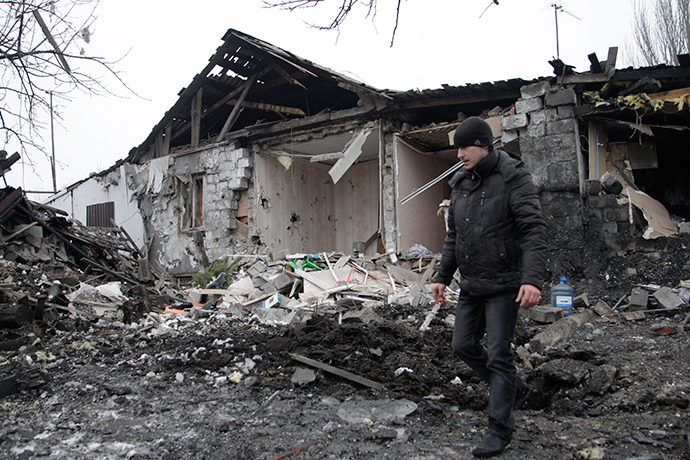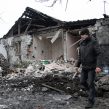
Ukraine on the Brink: Donbas Conflict Escalates
Publication: Eurasia Daily Monitor Volume: 12 Issue: 16
By:

Following the outright collapse of the notional ceasefire in eastern Ukraine, Kyiv and Moscow have traded accusations and drifted further from pursuing a possible political solution. Neither side shows any meaningful commitment to the Minsk agreement reached in September 2014, while the local conflict zone has consequently erupted into its worst fighting since the tentative ceasefire was agreed. Moscow’s portrayal of the Kyiv leadership, Western policy and the North Atlantic Treaty Organization (NATO) represents a mere caricature of events and developments, leaving the Kremlin’s actual stance impossible to determine. Russia’s actions, in offering both direct and indirect support to the rebels in Ukraine’s east, seem to indicate overall dissatisfaction with the Minsk agreement (see EDM, January 20).
In the aftermath of the fall of Donetsk airport and the upsurge in violence, the North Atlantic Alliance strongly condemned Moscow’s role. NATO Secretary General Jens Stoltenberg issued a statement blaming Moscow for the latest eruption of violence in Ukraine: “For several months we have seen the presence of Russian forces in eastern Ukraine, as well as a substantial increase in Russian heavy equipment such as tanks, artillery and advanced air defence systems. Russian troops in eastern Ukraine are supporting these offensive operations with command and control systems, air defence systems with advanced surface-to-air missiles, unmanned aerial systems, advanced multiple rocket launcher systems, and electronic warfare systems” (Nato.int, January 24).
Nevertheless, the latest rebel offensive and Moscow’s support for their cause appears to be limited in its aims. Russian media confirmed that fighting was in progress along much of the contact line. The critical area, from the perspective of the “Donetsk People’s Republic” (DPR) rebels, seems to be around Avdeyevka, with the purpose of pushing Ukrainian heavy artillery away from Donetsk (Informnapalm.org, January 8). Indeed, the somewhat limited aims of the rebels and Moscow’s objectives in Donbas (eastern Ukrainian region encompassing the Donetsk and Luhansk provinces) are reflected in critical commentaries in the Russian media. These converge around the central issue of the presence of Ukrainian artillery close to separatist-held territory.
President Vladimir Putin’s recent offer to his Ukrainian counterpart, Petro Porshenko, hinged on the withdrawal of heavy artillery in the conflict zone. The process of informal negotiations between Moscow and Kyiv, described by one source in the Russian presidential administration as a permanent process, reached an impasse prior to the fall of Donetsk airport (Vedomosti, January 20). The same well-placed source told Vedomosti that until Ukrainian army artillery around Donetsk is withdrawn, any effort to promote talks on the crisis will be “fruitless.” Moreover, during recent operations since securing Donetsk airport, the rebel forces’ flanking movement—which, according to NATO, is “spearheaded” by Russian regular troops—indicates a wider effort to force the Ukrainian military into retreat as a precursor to a more durable ceasefire. Seen from another perspective, it can also be considered a fresh “land grab”—possibly to strengthen the separatist claims to statehood (Vedomosti, January 20).
In the aftermath of the rebel attack on Mariupil on January 24, German Chancellor Angela Merkel told Putin by telephone that the incident was a clear violation of the ceasefire and urged him to do more to stop the violence. Russian media, however, characterized the attack as an isolated event, which may have served as a distraction from the real goals pursued by the rebels (Vzglad, January 24). With the Moscow-backed rebel operations continuing along the line of contact, many observers feared a separatist advance on the strategically important port city of Mariupil, in order to land-link mainland Russia to Crimea (TASS, January 25). That “advance” did not appear to follow, and Russian sources suggest the focus remained on pushing Ukrainian artillery away from Donetsk and to a lesser extent encircling Debaltseve (Moskovskiy Komsomolets, January 24).
Some Russian commentators see these developments in Donbas as a reflection of the extent to which the Kremlin is caught in a dilemma. This interpretation portrays Russia’s actions as defensively motivated, as part of its response to an alleged anti-Russian coup in Kyiv and strategically to prevent Ukraine’s drift toward the West. Putin claims to want to implement the Minsk agreement, but recognizes that Russia gains little from it; this leaves him unwilling to commit to war in Ukraine and equally indecisive concerning de-escalating the conflict (Gazeta, January 22). Paradoxically, Poroshenko shares a similar dilemma, as he has staked a great deal of political currency on the ill-fated anti-terrorist operation in eastern Ukraine; if he stops the use of military force against the rebels, some will portray such a decision as a sign of outright defeat. The military solution to the conflict has evaded Poroshenko, simply because the military option is not viable (see EDM, January 20).
However, Putin’s strategic dilemma runs significantly deeper. Damaged relations with the European Union and the domestic economic downturn complicate and narrow his range of options. Russia’s relations with NATO remain strained, despite the Alliance re-establishing direct contact with Chief of the General Staff, Army-General Valery Gerasimov. NATO no longer sees Russia as a partner, and one commentary in Vedomosti highlighted the Alliance’s scrutiny of Russia’s new Military Doctrine. Moreover, as NATO has responded to Moscow’s actions in Ukraine by seeking to reassure its members in Central Eastern Europe and the Baltic States, one Russian defense ministry source expressed the view that Brussels is awaiting Moscow’s implementation of counter-measures against the beefed-up Alliance presence closer to Russia (Vedomosti, January 23).
In this complex and unpredictable strategic environment, Putin’s dilemma is further complicated by his reading of the Minsk agreement, clear dissatisfaction with this as a basis for lasting peace and, a perception that the West wants to hold Moscow to the agreement without applying equal pressure on Kyiv. The only way to allow it to unravel is to support a fresh rebel offensive in Ukraine. This leaves Putin’s decision-making open to question: he may simply believe that now is not the right time to broker a deal. From Putin’s perspective, he also faces the problem of maintaining a tight grip on conflict escalation, which until now he has managed fairly well. The economics of the crisis make no sense, but any further escalation of the sanctions regime against Russia may narrow Putin’s options still further.




